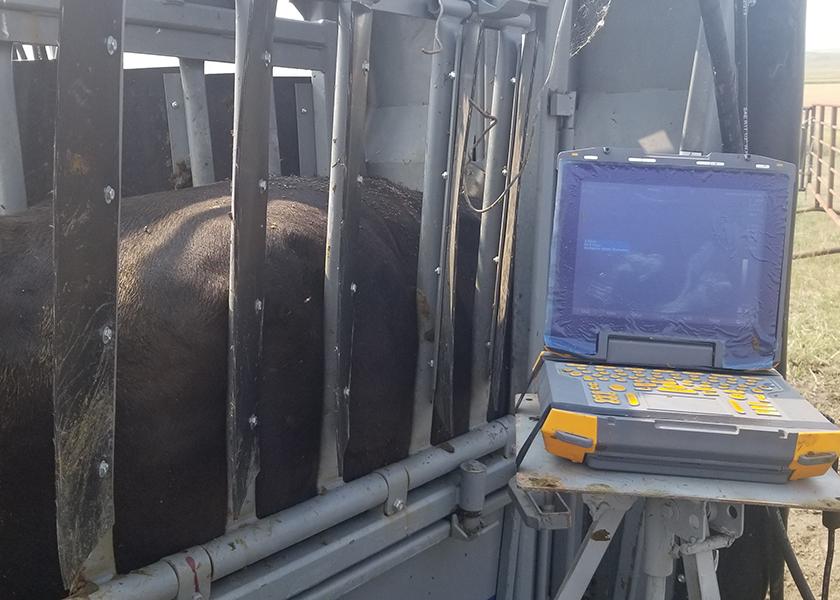While many U.S. beef producers work with their veterinarian to do pregnancy checks, a large percentage still don’t. As recently as 2020, a USDA survey showed only 31.6% of beef producers in the U.S. use any pregnancy diagnosis tool (NAHMS, 2020) in their herds.
Pregnancy checks are one of the mainstays of Dr. JD Folsom’s beef cattle practice, Cattle Health & Reproduction Services, based in Rexburg, Idaho.
Folsom addressed the benefits of pregnancy checking – the payoffs for producers – during a recent episode of “Doc Talk” with Host, Dr. Dan Thomson, PAC veterinarian and professor emeritus at Iowa State University. Folsom uses ultrasound technology almost exclusively.
Folsom says there are at least two valuable reasons for producers to have “preg checks” done. Both offer significant efficiency and financial benefits.
1. The primary benefit is to make sure the cow or heifer is pregnant.
“We have a considerable amount of snow in this area and by Thanksgiving, we’re feeding hay. You’re going to spend $200 to $300 to feed a cow, and if that cow’s not carrying a calf that’s a considerable cost,” Folsom says.
The producer is then able decide whether to retain that animal or send her to town and reduce their winter feeding expenses.
2. The second benefit from a timely preg check is the veterinarian is able to stage the pregnancy and determine the gender of the fetus.
“This (ultrasound) is a good management tool that the producer can use to identify late calvers, for instance. It can also help producers narrow down the amount of time they will have to spend in their calving season,” Folsom says.
He describes his customer base as fitting into two primary categories. One group is made up of large-scale farmers who like to start the calving process by the end of January, so they can be done before they need to get into fields to do tillage and other crop prep work.
The second category of producers is made up of non-farmers who don’t want to start the calving process until sometime in March.
A Nod To Better Technology
Folsom says ultrasound technology has made the process of preg checking cattle more accurate.
“Some veterinarians will use a (probe) introducer, but if I’m preg checkingwith the ultrasound probe in my hand, I feel like I can do a better job that way,” he says.
Folsom decides when to start doing ultrasounds within a herd, depending on how long the bull was turned in with the cattle and then removed.
“With ultrasounding we have to wait at least 30 days after pulling those bulls off so we can see a heartbeat,” he tells Thomson.
He likes to begin ultrasounding by mid-July, starting with heifers.
As for when the ultrasounds are no longer effective, Folsom says there’s no time limit but his experience says they are most accurate for staging, especially, when done before 110 days of pregnancy.
“In my experience, once you get past four months, that calf will drop deep down into the belly, and there’s more room for error,” he explains.
Coaching Producers For Higher Success Rates
As for timely pregnancy rates, Folsom says his beef producers are achieving successful rates when cows are in good body condition.
“When they’re healthy and their mineral status is good, we’ll typically see 60% to 65% in that first cycle, and then another 20% to 30% in that second cycle,” he says. “Then you’ll see some stragglers in the third cycle.
“If we’re way off that 60% at the beginning – maybe the cows were too thin going into breeding season – then that’s something we need to look into,” he adds.
“Data can be a big help with this,” Thomson says. “The veterinarian can provide data (on past success rates) and a set of eyes to help producers identify if there’s a problem so it can be addressed.”
Folsom agrees and says it’s difficult for anyone to keep track of the details on the cow herd all in their head. “Accurate records can tell you where you’re doing well and where there are areas and room for improvement.”
Identifying Other Management Needs
As Folsom meets with producers, he likes to address cattle body condition scores, vaccine protocols and vaccination timing, turnout timing for the bull, range/forage conditions and mineral status of the animal.
“We can kind of judge or guide the conversation with the producer based on the condition of the cow,” he says.
For vaccinations, Folsom says he tells producers the “gold standard” on timing is to vaccinate 60 days prior to breeding. At a bare minimum, vaccinations should be done at 30 days prior to breeding and 45 days is even better, he adds.
“We don’t want to do anything within that 30-day window before bulls go out,” Folsom says.
“We will develop heifers on a kind of a modified live programs and then, as soon as they’re confirmed pregnant, they’ll go into a killed vaccine program,” he adds.
You can watch the discussion between Drs. Folsom and Thomson on Doc Talk here: DocTalk Ep 490 – Preg Checking and Interpretation
Bovine Veterinarian: Rhonda Brooks September 25, 2024
Photo: NDSU








